#medieval scorpions
Text
Medieval Scorpions Effortpost
So yesterday I reblogged this post featuring an 11th-century depiction of the Apocalypse Locusts from Revelations, noting the following incongruity as another medieval scorpion issue:
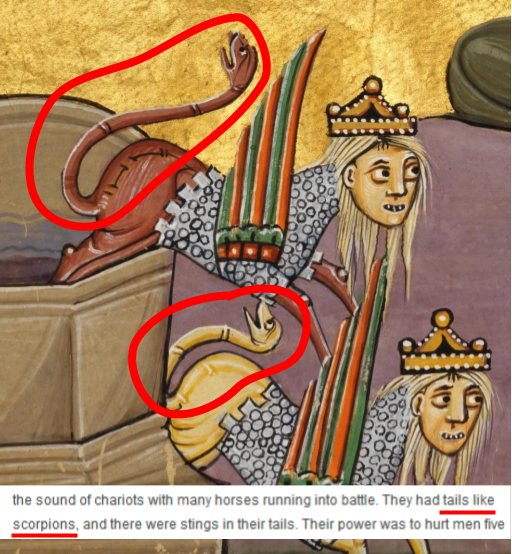
The artist, as you can see, has interpreted "tails like scorpions" as meaning "glue cheerful-looking snakes to their butts".
Anyway, it occurred to me that the medieval scorpion thing might not be as widely known as I think it is, and that Tumblr would probably enjoy knowing about it if it isn't known already. So, finding myself unable to focus on the research I'm supposed to be doing, I decided to write about this instead. I'll just go ahead and put a cut here.
As we can see in the image above, at least one artist out there thought a "scorpion" was a type of snake. Which makes it difficult to draw "tails like scorpions", because a snake's tail is not that distinctive or menacing (maybe rattlesnakes, but they don't have those outside the Americas). So they interpreted "tails like scorpions" as "the tail looks like a whole snake complete with head".
Let me tell you. This is not a problem unique to this illustration.
See, people throughout medieval Europe were aware of scorpions. As just alluded to, they are mentioned in the Bible, and if the people producing manuscripts in medieval Europe knew one thing, it was Stuff In Bible. They're also in the Zodiac, which medieval Europe had inherited through classical sources. However, let's take a look at this map:
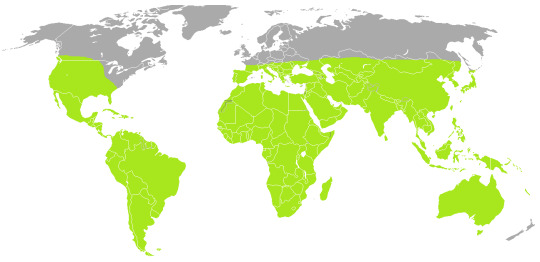
That's Wikipedia's map of the native range of the Scorpiones order, i.e., all scorpion species. You may notice something -- the range just stops at a certain northern latitude. Pretty much all of northern Europe is scorpion-free. If you lived in the north half of Europe, odds were good you had never seen a scorpion in your life. But if you were literate or educated at all, or you knew they were a thing, because you'd almost certainly run across them being mentioned in texts from farther south. And those texts wouldn't bother to explain what a scorpion was, of course -- everyone knows scorpions, right? When was the last time you stopped to explain What Is Spiders?
So medieval writers and artists in northern Europe were kind of stuck. There was all this scorpion imagery and metaphor in the texts they liked to work from, but they didn't really know what a scorpion was. Writers could kind of work around it (there's a lot of "oh, it's a venomous creature, moving on"), but sometimes they felt the need to break it down better. For this, of course, they'd have to refer to a bestiary -- but due to Bestiary Telephone and the persistent need of bestiary authors to turn animals into allegories, one of the only visual details you got on scorpions was that they... had a beautiful face, which they used to distract people in order to sting them.
And look. I'm not here to yuck anyone's yum, but I would say that a scorpion's face has significant aesthetic appeal only for a fairly small segment of the population. I'm sure you could get an entomologist to rhapsodize about it a bit, but your average person on the street will not be entranced by the face of a scorpion. So this did not help the medieval Europeans in figuring out how to depict scorpions. There was also some semantic confusion -- see, in some languages (such as Old and Middle English), "worm" could be a general term for very small animals of any kind. But it also could mean "serpent".* So there were some, like our artist at the top of the post, who were pretty sure a scorpion was a snake. This was probably helped along by the fact that "venomous" was one of the only things everyone knew about them, and hey, snakes are venomous. Also, Pliny the Elder had floated the idea that there were scorpions in Africa that could fly, and at least one author (13th-century monk Bartholomaeus Anglicus) therefore suggested that they had feathers. I don't see that last one coming up much, I just share it because it's funny to me.
*English eventually resolved this by borrowing the Latin vermin for very small animals, using the specialized spelling wyrm for big impressive mythical-type serpents, and sticking with the more specific snake for normal serpents.
Some authors, like the anonymous author of the Ancrene Wisse, therefore suggested that a scorpion was a snake with a woman's face and a stinging tail. (Everyone seemed to be on the same page with regards to the fact that the sting was in the tail, which is in fact probably the most recognizable aspect of scorpions, so good job there.) However, while authors could avoid this problem, visual artists could not. And if you were illustrating a bestiary or a calendar, including a scorpion was not optional. So they had to take a shot at what this thing looked like.
And so, after this way-too-long explanation, the thing you're probably here for: inaccurate medieval drawings of scorpions. (There are of course accurate medieval drawings of scorpions, from artists who lived in the southern part of Europe and/or visited places where scorpions lived; I'm just not showing you those.) And if you find yourself wondering, "how sure are you that that's meant to be a scorpion?" -- all of these are either from bestiaries or from calendars that include zodiac illustrations.
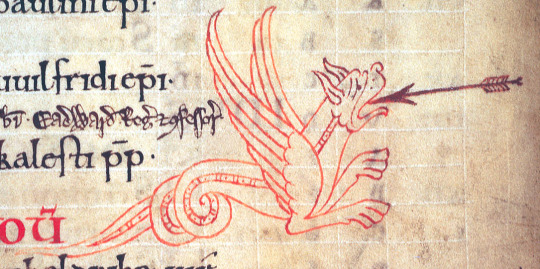
11th-century England, MS Arundel 60. (Be honest, without the rest of this post, if I had asked you to guess what animal this was supposed to be, would you have ever guessed “scorpion”?)
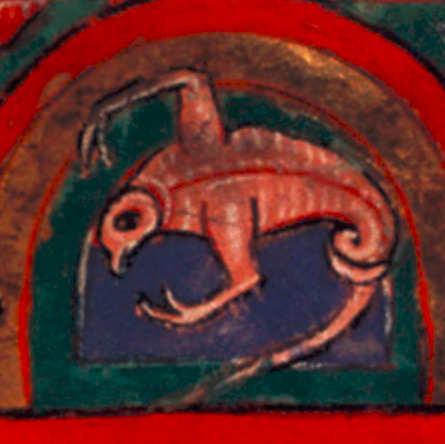
12th-century Germany, "Psalter of Henry the Lion". (Looks a bit undercooked. Kind of fetal.)
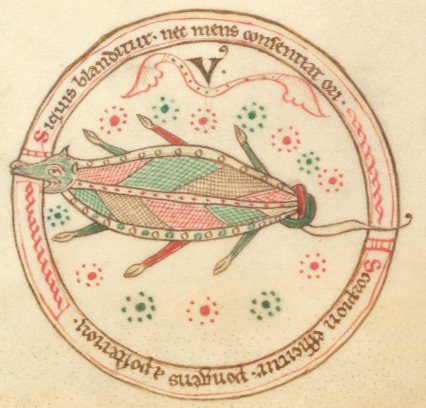
12th-century France, Peter Lombard's Sententiae. (Very colorful, itsy bitsy claws, what is happening with that tail?)
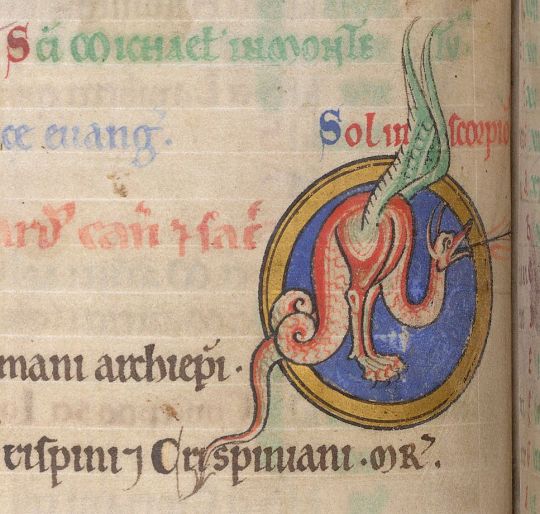
12th-century England, "The Shaftesbury Psalter". (So a scorpion is some sort of wyvern with a face like a duck, correct?)

13th-century France, Thomas de Cantimpré's Liber de natura rerum. (I’d give them credit for the silhouette not being that far off, but there’s a certain bestiary style where all the animals kind of look like that. Also note how few of these have claws.)
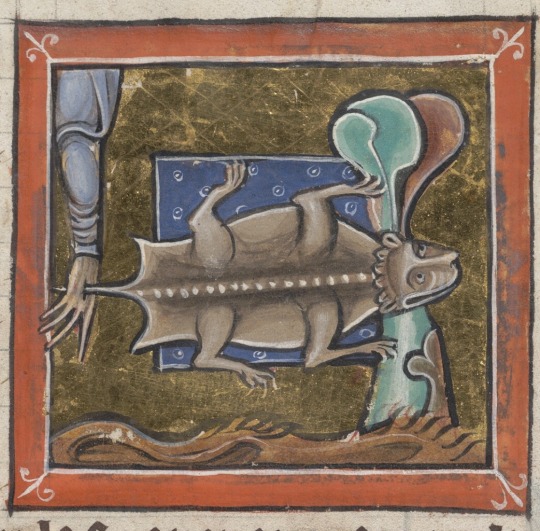
13th-century England, "The Bodley Bestiary". (Mischievous flying squirrel impales local man’s hand, local man fails to notice.)
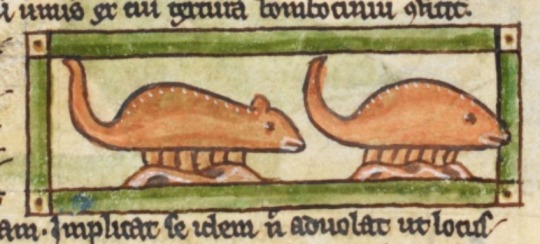
13th-century England, Harley MS 3244. (A scorpion is definitely either a mouse or a fish. Either way it has six legs.)
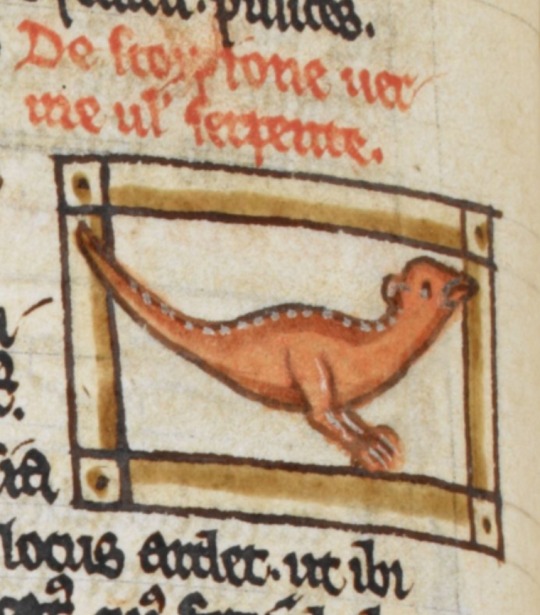
13th-century England, Harley MS 3244. (Wait, no, it’s a baby theropod, and it has two legs. (Yes, this is the same manuscript, that’s not an error, this artist did four scorpions and no two are the same.))

13th-century England, Harley MS 3244. (Actually it’s a lizard with tiny ears and it has four legs.)

13th-century England, Harley MS 3244. (Now that we’re at the big fancy illustration, I think I’ve got it — it’s like that last one, but two legs, longer ears, and a less goofy face. Also I’ve decided it’s not pink anymore, I think that was the main problem.)

13th-century England, MS Kk.4.25. (A scorpion is a flat crocodile with a bear’s head.)
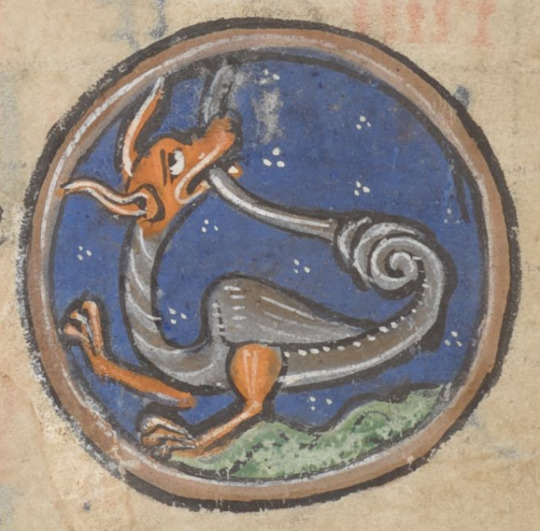
13th-century England, "The Huth Psalter". (Wyvern but baby! Does not seem to be enjoying biting its own tail.)
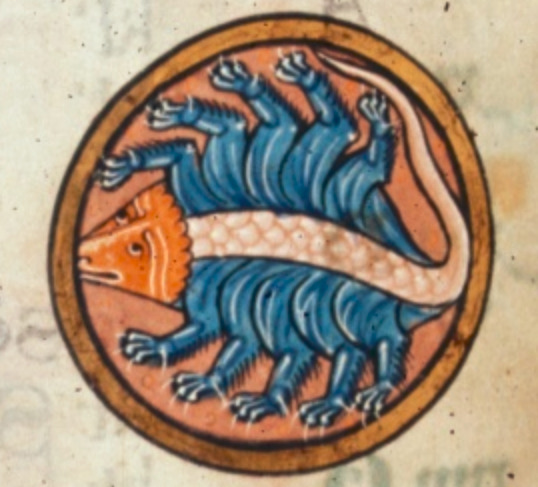
13th-century England, MS Royal 1 D X. (This triangular-headed gentlecreature gets the award for “closest guess at correct limb configuration”. If two of those were claws, I might actually believe this artist had seen a scorpion before, or at least a picture of one.)

13th-century England, "The Westminster Psalter". (A scorpion is the offspring of a wyvern and a fawn.)
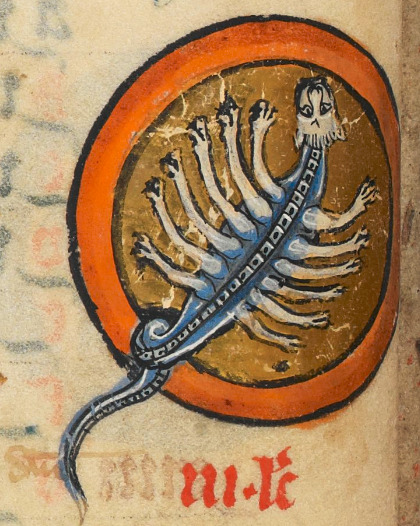
13th-century England, "The Rutland Psalter". (Too many legs! Pull back! Pull back!)

13th or 14th-century France, Bestiaire d'amour rimé. (This is very similar to the fawn-wyvern, but putting it in an actual Scene makes it even more obvious that you’re just guessing.)
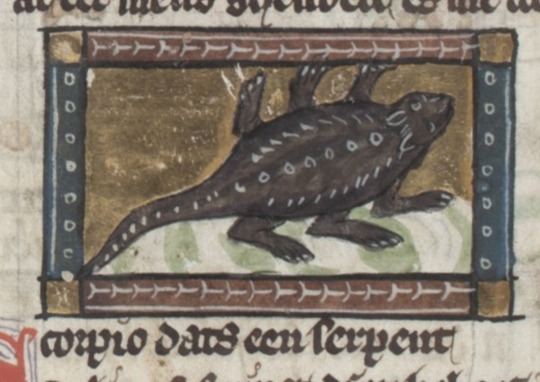
14th-century Netherlands, Jacob van Maerlant's Der Naturen Bloeme. (More top-down six-legged guys that look too furry to be arthropods.)

14th-century Germany, MS Additional 22413. (That is clearly a turtle.)

14th-century France, Matfres Eymengau de Beziers's Breviari d'amor. (Who came up with that head shape and what was their deal?)
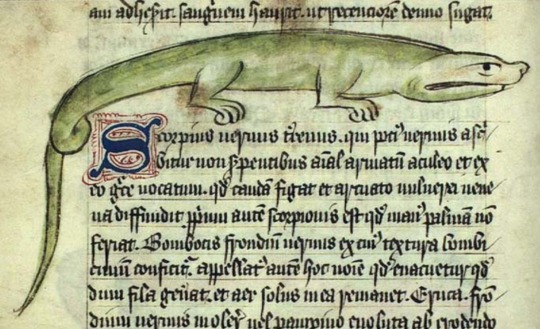
15th-century England, "Bestiary of Ann Walsh". (Screw it, a scorpion is a big lizard that glares at you for trying to make me draw things I don’t know about.)
I've spent way too much time on this now. End of post, thank you to anyone who got all the way down here.
#medieval#medieval creatures#medieval art#scorpions#medieval scorpions#manuscript#medieval manuscripts#illuminated manuscript
6K notes
·
View notes
Text

@maniculum whoa check out this scorpion from al-Qazwini’s Wonders of Creatures!
140 notes
·
View notes
Text


scorpio
in an astrological-astronomical manuscript, germany, c. 1445
source: Berlin, SBB, Ms. germ. fol. 244, fol. 53r
#it's ok i wouldn't know how to draw a scorpion either#15th century#astrology#zodiac signs#scorpio#medieval astrology#medieval art#manuscript illumination#scorpion
486 notes
·
View notes
Text


Day 3: Medieval AU
#mk#mortal kombat#kuai liang#hanzo hasashi#subscorp#subscorpweek2023#armor#medieval#scorpion#sub-zero#this lliterally killed me#but it was so worth it
65 notes
·
View notes
Photo
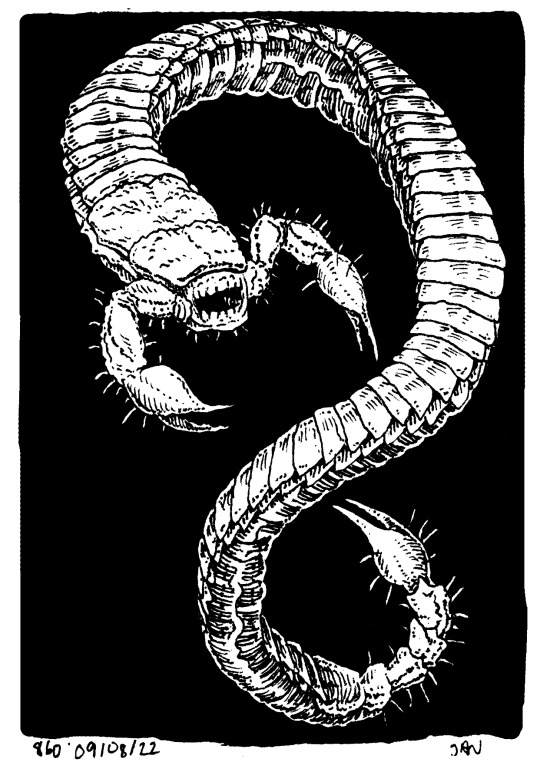
Avarice Wyrm, the 215th Known One.
Suggested by @thecreaturecodex, based on the adventures of Guerrin Meschino.
”I saw worms that resembled very large scorpions that had three mouths for biting and one, which was much larger, for eating.”
“They are those who are avaricious and miserly toward their parents, God, and the poor. In fact, avarice is only a form of self-harm because you love neither God nor your family. These individuals were so avaricious that they despaired and ended up here.” - Travels to the Otherworld and Other Fantastic Realms: Medieval Journeys into the Beyond, Claude Lecouteux, Corinne Lecouteux
#im hesitating with avaricious worm but english is not my mother tongue what do you think ??#smaugust#worm#thecreaturecodex#greed#sin#medieval#Guerrin Meschino#this is again an amazing suggestion#i never heard of that text now i should read it ahah#oh and i realized after but the composition might be influenced bu kraglynn's recent ask !! go see my recent posts#it wasnt my intention but it looks very similar ahah#human#scorpion#the Known Ones#860#octem 108#terra 4#chimera#monster#creature design#bestiary
176 notes
·
View notes
Text

LO! BEHOLD THE MIGHTY MANTICORE, KING OF BEASTS!
the most kingly and kickass combination of beasts imaginable
#Manticore#mythical creatures#Heraldic beast#Tattoo design#herald#Lion#medieval#Medieval art#scorpion#engraving
15 notes
·
View notes
Text

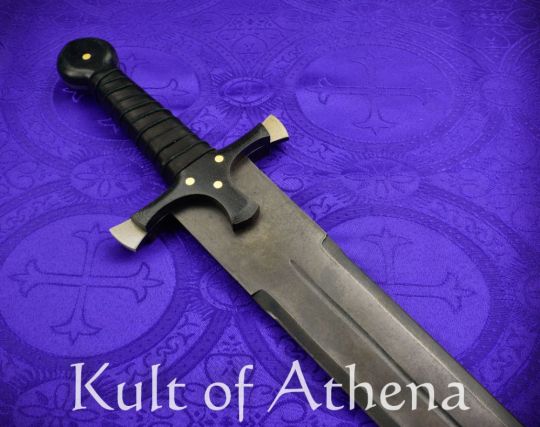
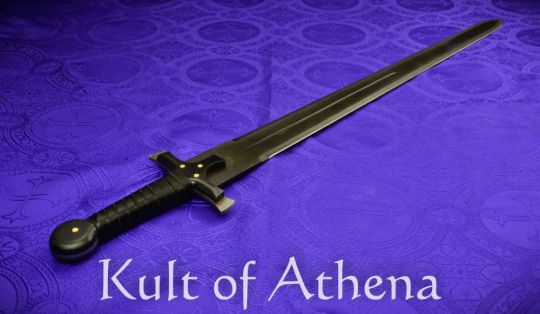
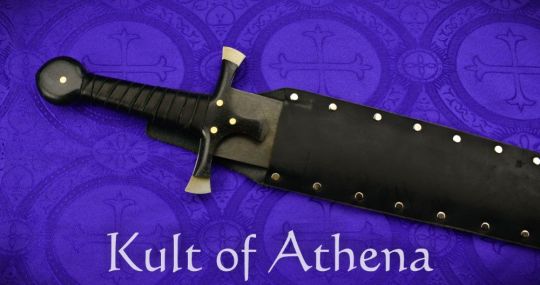
Scorpion – Dark Knights Templar Sword with Leather Sheath
The Dark Knight’s Templar Sword from Scorpion is a uniquely tough and robust medieval sword with its riveted full tang construction. The wide blade is purpose built for durability against targets that would break many other swords and is crafted from 1095 high carbon steel which has been well-tempered to a 57 HRc hardness. The hilt is fashioned from very tough black linen micarta composite which was stoutly riveted to the thick tang and finished with a grip wrap of spiralled leather. Tough and dependable, this version of the medieval knight’s sword brings modern full tang construction to a classic design. Included is a sheath of thick and durably riveted leather with a belt loop for wear.
#Kult of Athena#KultOfAthena#New Item Wednesday#Scorpion Swords and Knives#Dark Knights Templar Sword with Leather Sheath#Dark Knights Templar Sword#sword#swords#weapon#weapons#blade#blades#European Swords#European Weapons#Medieval Swords#Medieval Weapons#1095 High Carbon Steel#Battle Ready
10 notes
·
View notes
Text
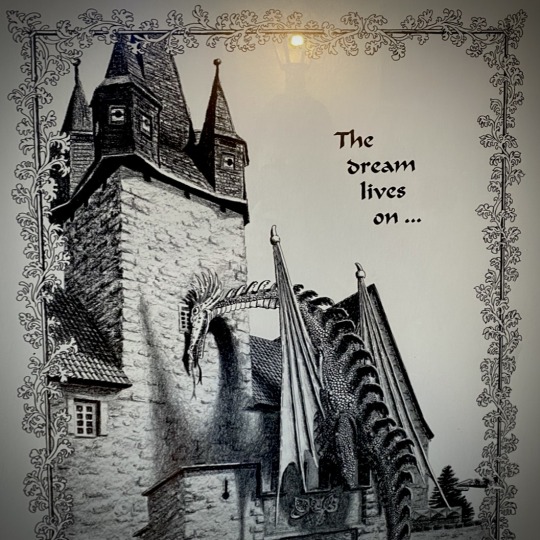

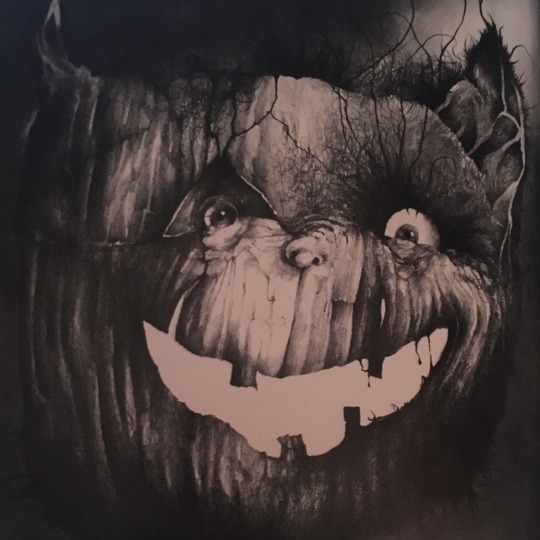


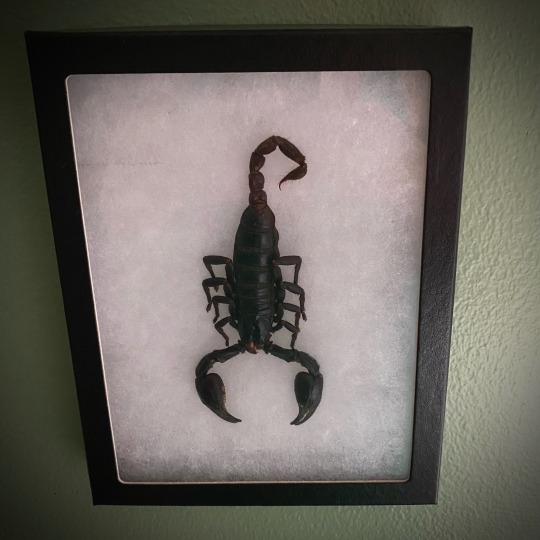
Noir
#personal#my photos#scorpion#taxidermy#dragon#medieval#pentagram#photoset#photo set#photography#stephen gammell#liminal#halloween#jack o lantern#witch#witchy
3 notes
·
View notes
Text
my favourite necklace just fucking BROKE
#it had real life scorpion suspended in resin that GLOWS in the DARK#the scorpions name is ricky#if i could show a medieval peasant one thing it would have been this necklace but now it's BROKEN#ricky i miss u
4 notes
·
View notes
Photo

#meridian59#meridian 59#free#mananode#mana#node#giant scorpion#steam#freetoplay#f2p#mmorp#medieval#fantasy#m59#mmo rpg#rpg#FREEMMORPG#freemmo#first 3d mmorpg#screenshot#retrogaming#pc gaming#freesteamgames#Dark Art#art
2 notes
·
View notes
Note

chonky scorpion (the hours of mary of burgundy, flanders, c. 1470. Vienna, ÖNB, Cod. 1857, fol. 11v)
Again, we're so close to a real scorpion. I think this is definitely a case of "only seen drawings", though, because the scale is way off. This one looks like it's the size of a large dog. Face kind of reminds me of a dog too.
There's definitely a lot of lobster in this design, but with a big stabby tail. The antennae are good. I also like the little hands it has instead of pincers.
Vaguely makes me think of paleoart depicting the giant arthropods you used to get millions of years ago when there was more oxygen in the atmosphere. If it weren't for that distinctly-non-arthropod face, I think this thing would fit right into that milieu.
Small Scuttling Beaſtie? this is a large scuttling beaſtie, ½
Pincers? ✘
Exoskeleton or Shell? ✓
Visible Stinger? ✓
Limbs? 10
I like the vibes on this one better than a regular scorpion, but they are vibes I will enjoy from a distance only. 4/5.
Total:
7.5 / 10
Prehistoric and stabby.
340 notes
·
View notes
Text
Thinking about scorpions,
Thinking about strange fantasy armor
Thinking about giving scorpions strange fantasy armor
#musings#creatures#scorpions#arachnids#bugs#you can make their telson into cool medieval weapons too
0 notes
Text


scorpion catching a dog with its tail
in the "buch der natur" (book of nature) by konrad von megenberg, illuminated manuscript, alsace, ca. 1442-1448
source: Heidelberg, UB, Cod. Pal. germ. 300, fol. 211r
#the KdiH (Katalog deutschsprachiger illustrierter Handschriften) calls her a “siren”#hoewever the Heidelberg library cearly calls this illustration a “scorpion” that is depicted as a water snake with the head of a woman#can't quite read the title#“Von der Schorppfen...”?#ok nvm the next page in the manuscript explicitly describes it as a scorpion#15th century#medieval art#medieval creatures#buch der natur#konrad von megenberg#medieval beasts#medieval illumination
351 notes
·
View notes
Text
making a detailed log of several Spider-Man concepts who wants them
#including but not limited to Pirate Spider Spider-Man#medieval Spider-Man ?? workshopping him still tbh#whip scorpion Spider-Man who doesn’t have web fluid but does have 2 very cool bullwhips#trying not to get into my own head too much about it#and the last time I made spidersonas for people a couple years ago#and it’s not working boy howdy I’m overthinking rn about personal stuff#but I am drowning them out with Spider-Man#sorry for getting weird in the tags agai
0 notes
Text
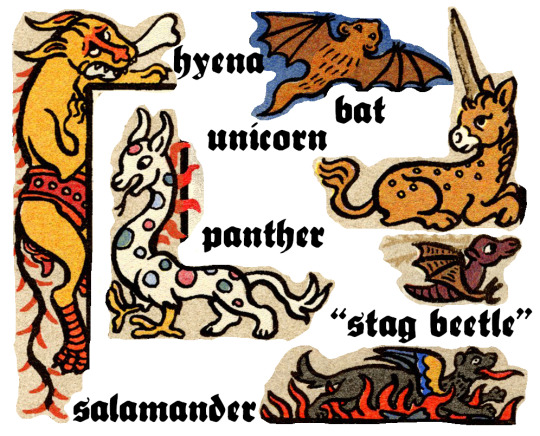
You may have seen me messing with creating risograph stickers yesterday...I'm going to make a set of medieval manuscript stickers, and need your not-legally-binding help to decide which ones! I've already decided on doing dragon, snail cat, basilisk, fox and scorpion stickers, and I'm planning for an 8 sticker set.
Note: these drawings are taken from my riso comic "Basilisk" and are just visual aids, and would be redrawn to fit the sticker format.
296 notes
·
View notes
Text





Scorpion – Tactical Messer Sword
An exclusive offering created by collaboration by Scorpion and Kult of Athena! The Tactical Messer which is purpose built for the cutting, cleaving and hacking asunder the toughest of targets with callous ease. The blade is crafted from 1095 high carbon steel which has been expertly tempered to a 57 HRc hardness. The darkened and blued blade is wide and quite adept and chopping into and splitting apart a target with its wide blade and thick spine which gives it plenty of mass to power it through the strike with grievous force. The Tactical Messer is made as robustly as is possible with its blade and tang being made from a single solid piece and is finished with composite grip scales which are solidly riveted directly to the tough blade tang.
Included is a leather sheath with a belt loop for wear.
#Kult of Athena#KultOfAthena#New Item Wednesday#Scorpion Swords and Knives#Tactical Messer Sword#sword#swords#weapon#weapons#blade#blades#European Swords#European Weapons#Medieval Swords#Medieval Weapons#Renaissance Swords#Renaissance Weapons#Short Swords#Messers#KOA Exclusive#1095 High Carbon Steel#Battle Ready#New Item#New Items
4 notes
·
View notes